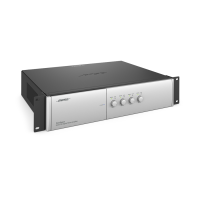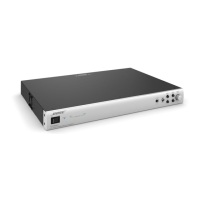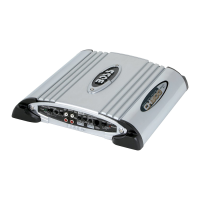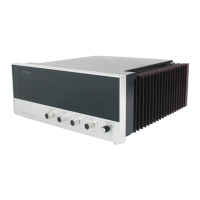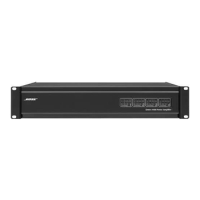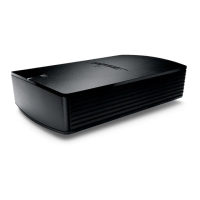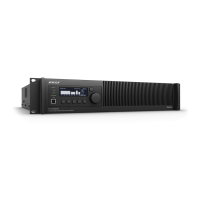60
Signal Processing (continued)
Linear regulators U510 [F3] and U513 [H3] provide separate 5V reference voltages to the Master
Level and Remote Level control circuits. Master Level potentiometer RT710 [Display PCB, B1]
operates as a voltage divider between signal ground (CW setting) and reference 5V (CCW
setting) producing a master level control voltage at RT710 wiper varying linearly from 0 to 5V.
When set to “Audio Taper”, level control configuration jumper JP401 [Signal Processor PCB, F1]
loads RT710 wiper to approximate a logarithmic Master Level control characteristic: “Linear
Taper” is the default setting. Reference ground and +5V potentials are supplied at the remote
level connector J802p1&4 [Interface PCB, B1] for connection to an external level control potenti-
ometer or voltage source. Remote control voltage input (J802p3) is filtered by lowpass network
R577 [Signal Processor sheet1, G3], C587 and buffered by U515A, which acts as a voltage
follower for positive inputs. Remote level control voltage output is taken at D520 cathode/
U515p2. R579 and R586 [G3] bias the remote input when no external connection is made,
assuring remote level control voltage of 0V. Master and Remote level control voltages are pas-
sively summed, attenuated and filtered at U514p3 [F1] by R590, R591, R574 and C571. Buffer
amplifier output U514p1 drives VCA control voltage port U511p3. The VCA gain control constant
is -1dB/ 6.2mV, and control voltage of 0V yields unity VCA gain. The control voltage applied to the
VCA varies from 0 to 620mV, setting VCA gain range of 0 to -100dB.
Filter circuits built with switched output op-amps U506 [F2] and U508 [G2] provide selectable
frequency high-pass filters, each with a second order Butterworth characteristic. U506 section A
and associated components form an 80Hz filter; U506 section B and associated components
form a 120Hz filter; and U508 section A and associated components form a 26Hz filter. Configu-
ration DIP switches S801G and S801H [Interface PCB, B4] set control voltages which select the
filter section inserted in the signal path. One of these three filters is always active. This circuit
block provides voltage gain of 1.59.
Limiting circuitry protects speaker loads from damage due to clipped amplifier output waveforms
and overdrive conditions. Power amplifier peak output level is compared to the amplifier rail
voltages to detect the onset of clipping. Amplifier output signal is attenuated by R463, R472
network, R463, C438 network [Signal Processor sheet2, C3] rejects high frequency noise.
Attenuated signal is applied to window comparator inputs U426p4 and U426p7 [D4]. Upper
comparison voltage is sampled from the VS
POS
rail via lowpass network R455, C436 and attenu-
ator network R446, R447 and applied to U426p5 [D3]. Lower comparison voltage is sampled
from the VS
NEG
rail via lowpass network R461, C437 and attenuator network R449, R450 and
applied to U426p6. When signal level at U426p4 exceeds the positive reference voltage at
U426p5, output U426p2 pulls down to –15V. Similarly, when signal level at U426p7 drops below
the negative reference voltage at U426p6, output U426p1 pulls down to –15V. Outputs U426p1
and U426p2 are OR’ed together and pulled up to 15V through voltage divider R444, R468, level-
shifting the signal before it is applied to comparator U427A [D3]: signal at this point switches
between 2V and 15V. At clip, input U427p4 drops below the 12.5V reference on U472p5, output
U427p2 turns off and is pulled up through R476. This turns on Q428 [E4], sinking current through
limiting resistor R479 to turn on the LED section of analog optical isolator U516 [F4]. When
illuminated by the LED, the resistance of U516’s photoconductive output section drops, forming
a voltage divider with R576 [Signal Processor sheet1, G2] and attenuating power amplifier input
signal level. Limiter time constants are set by the electro-optical characteristics of U516’s output
section, with typical attack time of 5ms and decay time of 500ms. Limiter operation is enabled by
closure of configuration DIP switch S801F [Interface PCB, B5] which turns Q431 [Signal Proces-
sor sheet2, E4] off.
THEORY OF OPERATION

